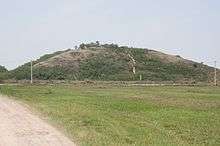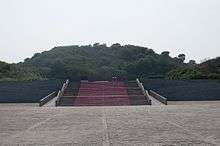Han Yang Ling Mausoleum
Coordinates: 34°26′37.67″N 108°56′26.56″E / 34.4437972°N 108.9407111°E


The Han Yang Ling Mausoleum (simplified Chinese: 汉阳陵; traditional Chinese: 漢陽陵; pinyin: Hàn Yáng líng) is the burial place of Emperor Jing, the fourth emperor of the Western Han Dynasty and his Empress Wang. The mausoleum complex is located in the Weicheng district of the City of Xianyang, Shaanxi Province, on the northern bank of the Wei River and about 20 km to the north of the city center of the provincial capital of Xi’an. It is composed of two large burial mounds, 86 smaller burial pits and a criminal's graveyard. The site today also hosts a museum. The largest of the two mounds is the burial place of the Jing Emperor, it sits next to the slightly smaller mound of his Empress Wang. The mausoleum is surrounded by 86 outer burial pits, 21 of which are accesible to visitors. The pits display more than 50.000 miniature terracotta figures reflecting the daily life of the Han emperor's court, including eunuchs, servants, tools and domesticated animals. The complex is one of the "Five Mausoleums" of the Western Han Dynasty (Chinese: 西汉五陵; pinyin: Xī Hàn Wǔ Líng).
In 2016, the discovery of the earliest tea traces known to date from the mausoleum of Emperor Jing was announced, indicating that tea was drunk by Han Dynasty emperors as early as 2nd century BC.[1]
| Wikimedia Commons has media related to Han Yang Ling. |
References
- ↑ Houyuan, Lu; et al. (7 January 2016). "Earliest tea as evidence for one branch of the Silk Road across the Tibetan Plateau". Nature. doi:10.1038/srep18955. Retrieved 17 August 2016.